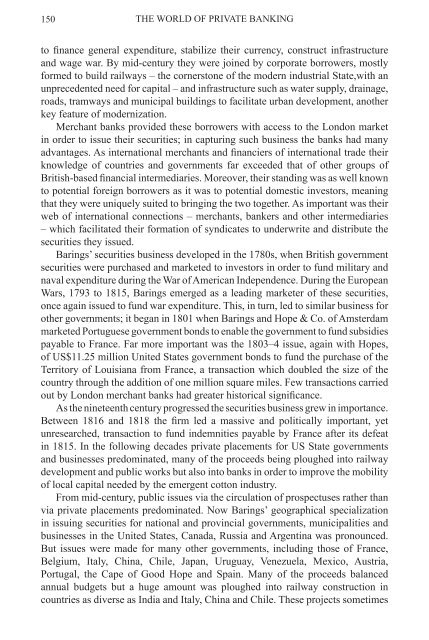the world of private banking
the world of private banking
the world of private banking
Create successful ePaper yourself
Turn your PDF publications into a flip-book with our unique Google optimized e-Paper software.
150<br />
THE WORLD OF PRIVAtE BANKING<br />
to finance general expenditure, stabilize <strong>the</strong>ir currency, construct infrastructure<br />
and wage war. By mid-century <strong>the</strong>y were joined by corporate borrowers, mostly<br />
formed to build railways – <strong>the</strong> cornerstone <strong>of</strong> <strong>the</strong> modern industrial State,with an<br />
unprecedented need for capital – and infrastructure such as water supply, drainage,<br />
roads, tramways and municipal buildings to facilitate urban development, ano<strong>the</strong>r<br />
key feature <strong>of</strong> modernization.<br />
Merchant banks provided <strong>the</strong>se borrowers with access to <strong>the</strong> London market<br />
in order to issue <strong>the</strong>ir securities; in capturing such business <strong>the</strong> banks had many<br />
advantages. As international merchants and financiers <strong>of</strong> international trade <strong>the</strong>ir<br />
knowledge <strong>of</strong> countries and governments far exceeded that <strong>of</strong> o<strong>the</strong>r groups <strong>of</strong><br />
British-based financial intermediaries. Moreover, <strong>the</strong>ir standing was as well known<br />
to potential foreign borrowers as it was to potential domestic investors, meaning<br />
that <strong>the</strong>y were uniquely suited to bringing <strong>the</strong> two toge<strong>the</strong>r. As important was <strong>the</strong>ir<br />
web <strong>of</strong> international connections – merchants, bankers and o<strong>the</strong>r intermediaries<br />
– which facilitated <strong>the</strong>ir formation <strong>of</strong> syndicates to underwrite and distribute <strong>the</strong><br />
securities <strong>the</strong>y issued.<br />
Barings’ securities business developed in <strong>the</strong> 1780s, when British government<br />
securities were purchased and marketed to investors in order to fund military and<br />
naval expenditure during <strong>the</strong> War <strong>of</strong> American Independence. During <strong>the</strong> European<br />
Wars, 1793 to 1815, Barings emerged as a leading marketer <strong>of</strong> <strong>the</strong>se securities,<br />
once again issued to fund war expenditure. This, in turn, led to similar business for<br />
o<strong>the</strong>r governments; it began in 1801 when Barings and Hope & Co. <strong>of</strong> Amsterdam<br />
marketed Portuguese government bonds to enable <strong>the</strong> government to fund subsidies<br />
payable to France. Far more important was <strong>the</strong> 1803–4 issue, again with Hopes,<br />
<strong>of</strong> US$11.25 million United States government bonds to fund <strong>the</strong> purchase <strong>of</strong> <strong>the</strong><br />
Territory <strong>of</strong> Louisiana from France, a transaction which doubled <strong>the</strong> size <strong>of</strong> <strong>the</strong><br />
country through <strong>the</strong> addition <strong>of</strong> one million square miles. Few transactions carried<br />
out by London merchant banks had greater historical significance.<br />
As <strong>the</strong> nineteenth century progressed <strong>the</strong> securities business grew in importance.<br />
Between 1816 and 1818 <strong>the</strong> firm led a massive and politically important, yet<br />
unresearched, transaction to fund indemnities payable by France after its defeat<br />
in 1815. In <strong>the</strong> following decades <strong>private</strong> placements for US State governments<br />
and businesses predominated, many <strong>of</strong> <strong>the</strong> proceeds being ploughed into railway<br />
development and public works but also into banks in order to improve <strong>the</strong> mobility<br />
<strong>of</strong> local capital needed by <strong>the</strong> emergent cotton industry.<br />
From mid-century, public issues via <strong>the</strong> circulation <strong>of</strong> prospectuses ra<strong>the</strong>r than<br />
via <strong>private</strong> placements predominated. Now Barings’ geographical specialization<br />
in issuing securities for national and provincial governments, municipalities and<br />
businesses in <strong>the</strong> United States, Canada, Russia and Argentina was pronounced.<br />
But issues were made for many o<strong>the</strong>r governments, including those <strong>of</strong> France,<br />
Belgium, Italy, China, Chile, Japan, Uruguay, Venezuela, Mexico, Austria,<br />
Portugal, <strong>the</strong> Cape <strong>of</strong> Good Hope and Spain. Many <strong>of</strong> <strong>the</strong> proceeds balanced<br />
annual budgets but a huge amount was ploughed into railway construction in<br />
countries as diverse as India and Italy, China and Chile. These projects sometimes












![[Pham_Sherisse]_Frommer's_Southeast_Asia(Book4You)](https://img.yumpu.com/38206466/1/166x260/pham-sherisse-frommers-southeast-asiabook4you.jpg?quality=85)



